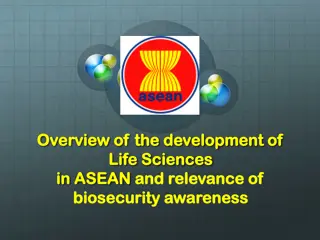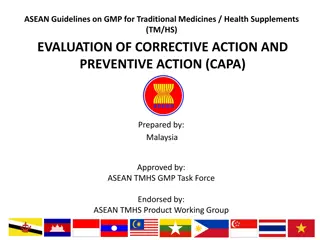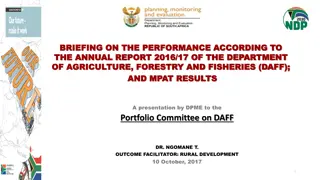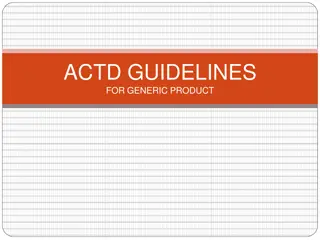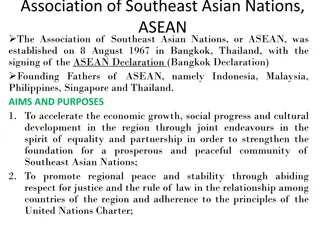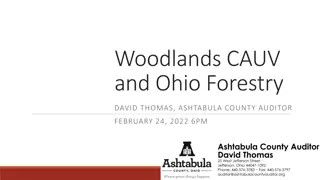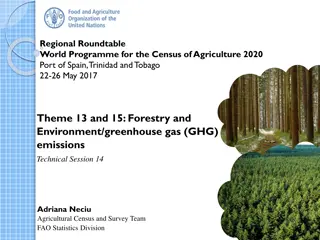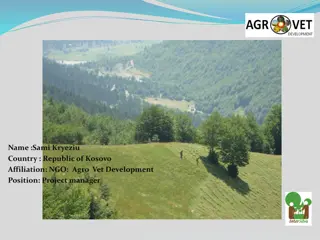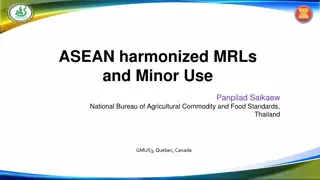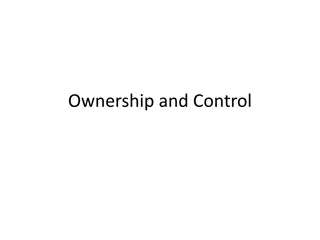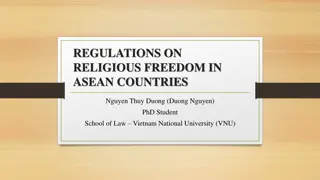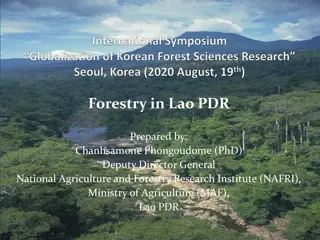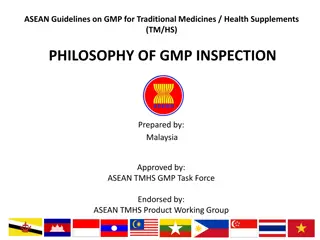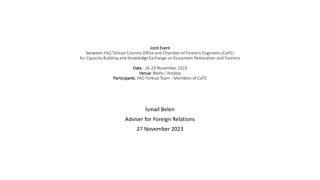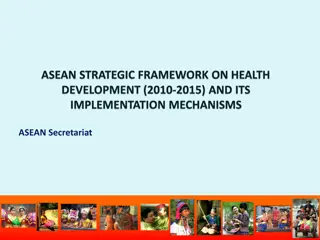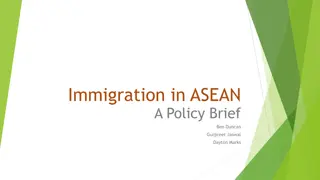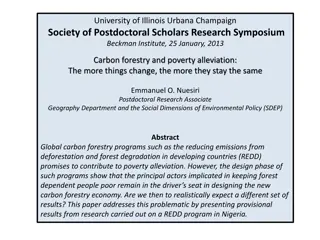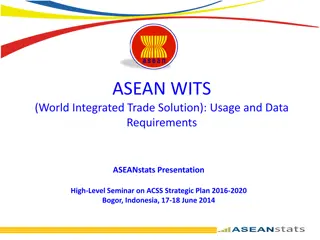ASEAN Guidelines for Agroforestry Development in Food, Agriculture, and Forestry Cooperation
The ASEAN cooperation on agriculture and forestry, established in 1968, encompasses various aspects such as food security, livestock, fisheries, and forestry. The ASEAN Food, Agriculture, and Forestry (FAF) Cooperation aim to achieve a vision of competitiveness, inclusivity, and resilience by 2025. The ASEAN Guidelines for Agroforestry Development play a crucial role in fostering sustainable practices in the FAF sector, aligning with the broader objectives of the ASEAN community towards economic integration, climate change resilience, and biodiversity conservation.
Uploaded on Sep 12, 2024 | 0 Views
Download Presentation

Please find below an Image/Link to download the presentation.
The content on the website is provided AS IS for your information and personal use only. It may not be sold, licensed, or shared on other websites without obtaining consent from the author. Download presentation by click this link. If you encounter any issues during the download, it is possible that the publisher has removed the file from their server.
E N D
Presentation Transcript
ASEAN Guidelines for Agroforestry Development Dian Sukmajaya FAFD, ASEAN Secretariat
Outline ASEAN Policy Framework in FAF Sector AEC Blueprint CSAP (bried) SP-FAF SPA for ASEAN Cooperation in Forestry Overview of the ASEAN Cooperation in Food Agriculture and Forestry (AMAF Structure) ASEAN Guidelines for Agroforestry Development
ASEAN 2025: Forging Ahead Together AEC by 2025: highly integrated and cohesive; competitive, innovative and dynamic; with enhanced connectivity and sectoral cooperation; and a more resilient, inclusive, and people-oriented, people- centred community, integrated with the global economy.
AEC Consolidated Strategic Action Plan (CSAP) To complement the AEC 2025 BP serve as single reference document intended for public on the key action lines toward economic integration (2016-2025) A tool to monitor and report the progress of the AEC BP 2025 facilitate stakeholders feedback from stakeholders Areas on the CSAP: Trade (goods & Services), Transport, Energy, FAF, Tourism, Minerals, Science and Technology, SME s, NDG.
What area that cut across on CSAP relevant to biodiversity? Climate Change increase resilience of climate change in agriculture and forestry ((adaptation & mitigation strategy), financing mechanism) Food Security Sustainable Forest Management (SFM) FLEGT, Social Forestry
BACKGROUND The ASEAN cooperation on agriculture was established in 1968, and was expanded in 1977 to include the greater area of agriculture and forestry. The ASEAN Food, Agriculture and Forestry (FAF) Cooperation includes food security, food handling, crops, livestock, fisheries, agricultural training and extension, agricultural cooperatives, forestry and joint cooperation in agriculture and forest products promotion scheme. 6
VISION OF FOOD, AGRICULTURE & FORESTRY (FAF) COOPERATION (2025) Competitive, inclusive, resilient and sustainable FAF sector Integrated with the Global economy Contributing to food and nutrition security and prosperity in ASEAN Based on single market and production base 7
GOALS OF FOOD, AGRICULTURE & FORESTRY (FAF) COOPERATION (2025) Ensuring equitable, sustainable and inclusive growth 1 Alleviating poverty and eradicating hunger 2 Ensuring food security, food safety and better nutrition 3 Deepening regional integration 4 Enhancing access to global markets 5 Increasing resilience, and contributing to mitigation and adaptation of climate change, natural disasters and other shocks 6 Achieving Sustainable Forest Management (SFM) 7 8
Strategic Thrusts Strategic Thrust 1: Enhance quantity and quality of production with sustainable, green technologies, resource management systems, and minimise pre- and post-harvest losses and waste Strategic Thrust 2: Enhance trade facilitation, economic integration and market access Strategic Thrust 3: Ensure food security, food safety, better nutrition and equitable distribution Strategic Thrust 4: Increase resilience to climate change, natural disasters and other shocks Strategic thrust 5: Assist small scale producers and SMEs to improve productivity, technology and product quality, to meet global market standards and increase competitiveness in line with the ASEAN Policy Blueprint on SME Development Strategic Thrust 6: Strengthen ASEAN joint approaches on international and regional issues Strategic Thrust 7: Promote sustainable forest management
Structure of ASEAN Cooperation in Food, Agriculture and Forestry ASEAN Ministry of Agriculture and Forestry (AMAF) Final as of November 2016 SOM-AMAF ATF Joint Committee on ASEAN Coop. & Joint Approaches in Agric. & Forest Products Promotion Scheme ASEAN Senior Officials on Forestry (ASOF) Genetically Modified Food Testing Network AWG on Halal Food ATF on Codex ASWG on ARD ASWG on Crops ASWG on AC ASWG on ATE ASWG on Livestock ARASFF ASCP AFSRB ASWG on Fisheries AWG on Forest Product Development EWG on Harmonization of Phyto- sanitary Measures NFPWG/ Industrial Clubs ASEAN NFP on Veterinary Product ACEDAC Board ASEAN Fisheries Consultative Forum Carrageenan AWG-CITES and Wildlife Enforcement Cocoa Notes: EWG on Harmonization of MRLs of Pesticides Coconut AWG: ASEAN Working Group Palm Oil AEG on GAHP ARASFF: ASEAN Rapid Alert System on Food and Feed AWG ASEAN Shrimp Alliance Forest and Climate Change Forest Products ASCP: ASEAN SPS Contact points.. Coffee ACCAHZ : ASEAN Coordinating Central for Animal Health and Zoonosis Tea ASEAN AVRDC Regional Network (AARNET) Steering Committee * AWG on Social Forestry Network ASWGAC: ASWG on Agriculture Cooperatives, Pepper ACCAHZ FCG on ASEAN- SEAFDEC Collaboration ASWG on ATE: Agricultural Training and Extension Peas & Beans ASWG on ARD: Agricultural Research and Development Tapioca Tuna ASWG AC: Agricultural Cooperatives ASEAN Ad hoc Communication Group for Livestock AWG on Forest Management Sericulture ACEDAC Board: ASEAN Centre for The Development of Agricultural Cooperatives AIGA: Avian Influanza Group in ASEAN EWG: Expert Working Group NFPW: National Focal Point Working Group TF on ASEAN Standards for Horticultural Produce ASEAN Ad-Hoc Veterinary Epidemiology Group EWG on ASEAN GAP ASEAN Laboratory Directors Forum ASEAN taskforce on Organic Agriculture] AIGA
VISION OF ASEAN COOPERATION IN FORESTRY (2025) Forest resources are sustainably managed at the landscape level to meet societal needs, both socio-economically and culturally, of the present and future generations, and to contribute positively to sustainable development. 11
SPA for ASEAN Cooperation in Forestry ST 1: Enhancing SFM ST 2: Enhancing Trade Facilitation, Economic Integration and Market Access ST 3: Enhancing the Forestry Resilience and Role in Climate Change ST 4: Institutional Strengthening and Human Resources ST 5: Strengthening ASEAN S Joint Approaches on Regional and International Issues Affecting the Forestry Sector
Key Priorities 2018-2019 (Forestry) ASEAN Guidelines for Agroforestry development (adopted) Manual for Assessing FLEG Implementation in AMS (adopted) Regional Community Forestry Assessment Tool drafted/developed Regional Agroforestry Training Manual/Modules drafted/developed ASEAN Guidelines for Detecting and Preventing Wildlife Trafficking drafted/developed Regional Voluntary Code of Conduct for Forest & Timber Companies in ASEAN drafted/developed Scoping Study on NTFP Standards
ASEAN GUIDELINES FOR AGROFORESTRY DEVELOPMENT
OBJECTIVES Promote the role of agroforestry in simultaneously achieving economic, environmental and social outcomes at farm, household and landscape levels. Guide the formulation of agroforestry policies, strategies and programs of ASEAN Member States and private-sector investments, as well as higher education agroforestry curriculum and programs. Help ASEAN Member States achieve their targets related to food security, green or sustainable growth, reduction of greenhouse-gas emissions, land restoration, watershed protection, gender equality, social/community forestry, climate-change adaptation and mitigation and, more generally, the Sustainable Development Goals. Strengthen partnerships among ASEAN Member States through joint action on agroforestry development.
Targets (for whom) Decision (policy) makers, program and/or project planners at national and sub-national levels, domestic and foreign investors, institutions for higher learning, local and international non-governmental organizations involved with agroforestry and development. civil society groups for advocacy purposes.
Guiding Principles Institutional Economic Environmental Socio-Cultural Technical Design Communication and Scaling
Institutional Principles Create an Enabling Environment: abide with existing international treaty, national laws (regulations), national agroforestry programs, funding support Ensure effective organisational capacity: Capacity of insitution, expertise, R&D, extension, module for higher education, stakeholders analysis Support effective cooperation and participative decision making: participatory approach, consider landscape approach, respect traditional knowledge
Economic Principles Recognise the value of goods and ecosystem services: promote agroforestry goods and ecosystem services, local knowledge of agroforestry products, provide incentives Enabling environment for agroforestry investments and markets: Develop financing schemes, policies for flexible investments, support trade promotion, marketing, direct and indirect incentives
Environmental Principles Maintain and enhance ecosystems services at farm and landscape scales: Ensure multi-purpose benefit (economic, social, environment), enhance ecosystem services, restoration, EIA for large-scale agroforestry, biodiversity, standard practices for ecosystem services Understand and manage trade offs: Project the magnitude of potential trade-offs and support decision-making by quantifying the economic and environmental costs and benefits of agroforestry intervention
Socio-cultural Principles Recognise and Respect local knowledge, traditions and choices: Consider local knowledge and choices, address unique needs for capacity development Support gender equity and social inclusion Acknowledge gender equity, ensure beneficiaries for smallholders and marginalised groups Ensure safeguards and tenure rights: Understand tenure rights of stakeholders, ensure security of land tenure rights, FPIC of rights holders
Technical design principles Design agroforestry options based on context Provide user-friendly, practicable decision support tools, ensure agroforestry options selected based on specific needs, consider balance economic, socio- cultural and environment benefit Select agroforestry components in a participatory manner: Consider local needs and biophysical conditions, consider stakeholders preference, examine applicable techniques for specific conditions, ensure active participation
Communication and scaling Effectively communicate agroforestry knowledge Provide good communication materials to better understand agroforestry, enhance communication capacity and knowledge management Plan for effective scaling up and sustainability Ensure stakeholders engagement, appropriate modalities for scaling, consider local specific conditions (biophysic, socio-culture, labor, market)
What Next for Agroforestry Guidelines? Develop Action Plan for Its Implementation Support policy development (review) at AMS Capacity building enhancement for AMS on several areas (awareness, field tools/manuals, training, etc) Sharing best practices and experiences among AMS
Way forward toward Mainstreaming AgroBiodiversity in ASEAN Identify and Develop Joint Proposal/Initiatives/Activities to support mainstreaming agrobiodiversity at national and regional level Promote and enhance dialogue on Mainstreaming Agrobiodiversity across the sectors at regional level Stocktake on best practices, policies, strategies in addressing agrobiodiversity in AMS Identify relevant existing platform to discuss the issues on Agrobiodiversity; as if necessary to provide Ad-Hoc Platform to bring experts from different sectors Resource mobilisation and partnership



